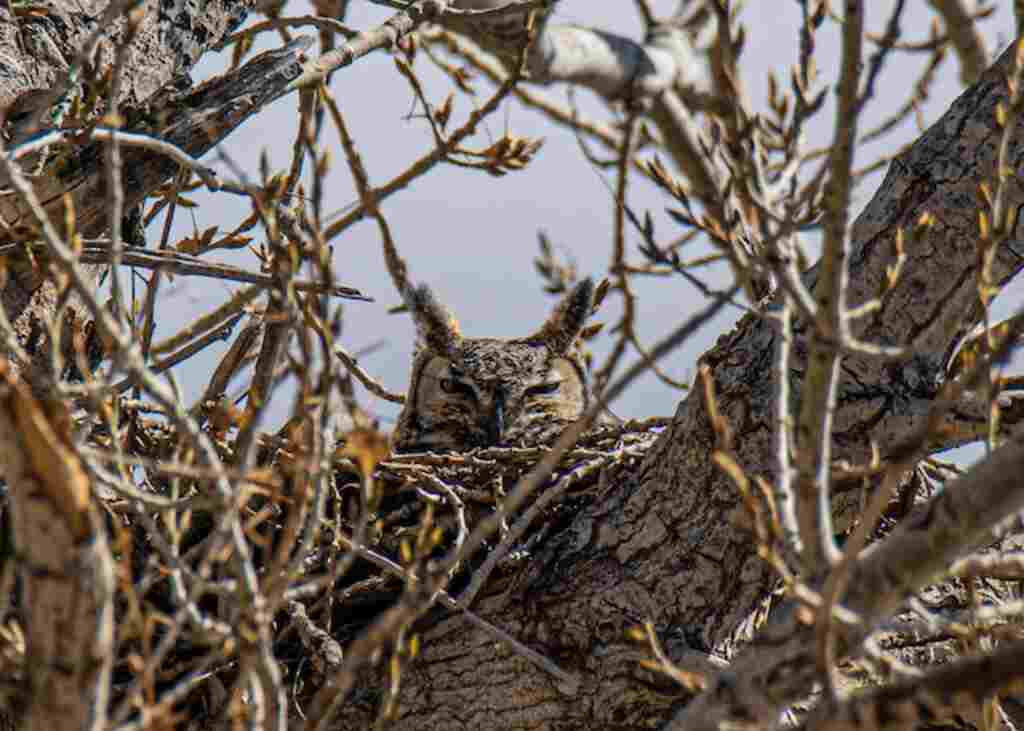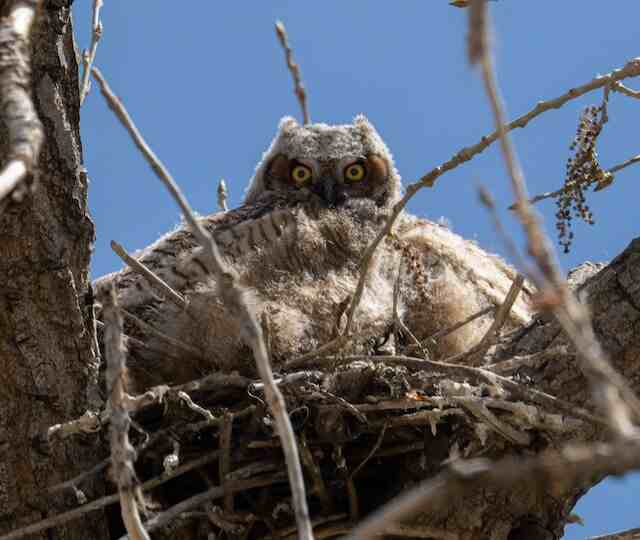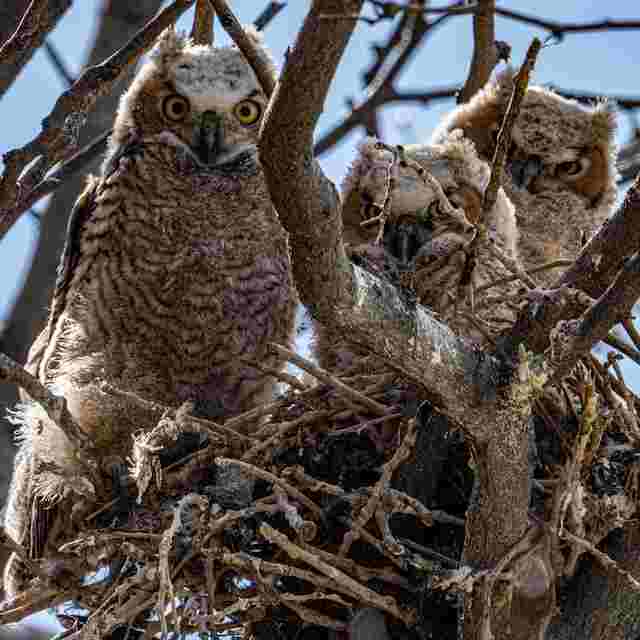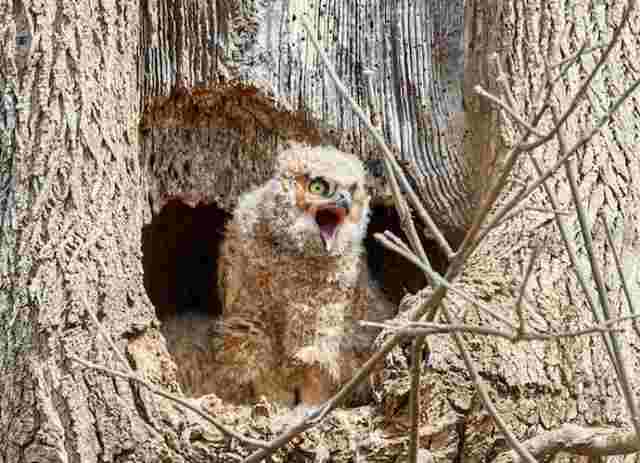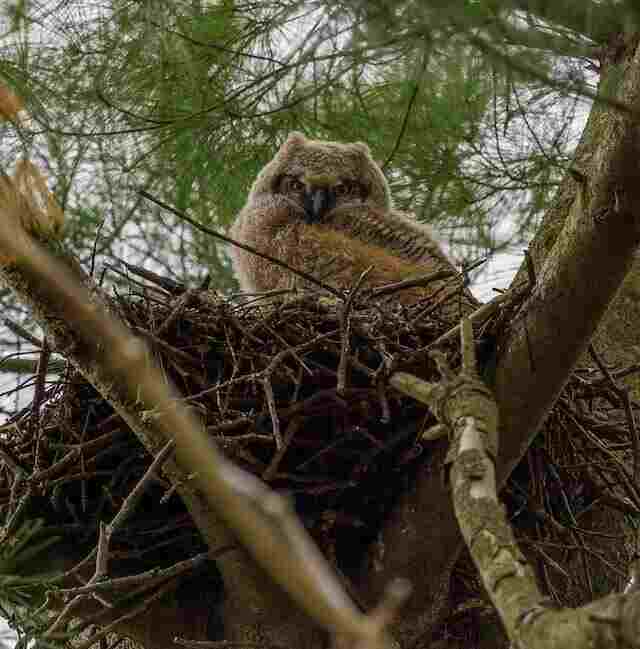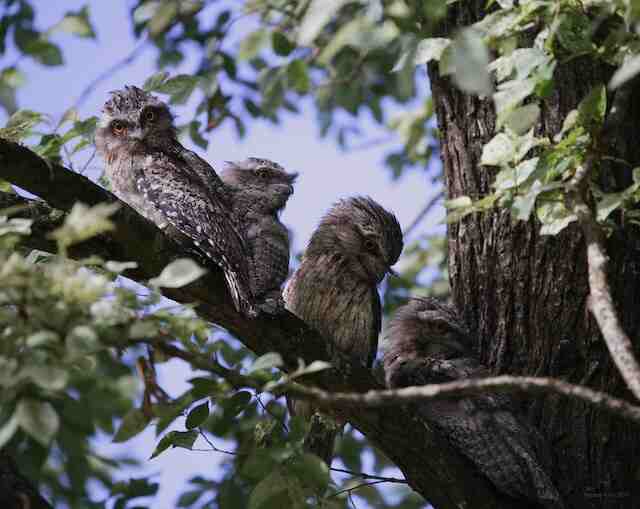Do owls lay eggs? The short answer is yes, but there’s more to it than just a simple “yes.” Owls are fascinating creatures with unique behaviors and adaptations.
In this article, we’ll explore the world of owl eggs, from how they’re laid to how they hatch. So, grab your binoculars and let’s take a closer look at these nocturnal birds of prey!
Table of Contents
- 1 Brief Overview of Owls
- 2 Explanation of Owl Reproduction
- 3 Question: Do Owls Lay Eggs?
- 4 Owl Reproduction
- 5 Egg-Laying Process in Owls
- 6 Factors Affecting Owl Egg-Laying
- 7 Unique Characteristics of Owl Eggs
- 8 Summary of Key Points
- 9 FAQs: Do Owls Lay Eggs?
- 9.1 How long does an owl sit on her eggs?
- 9.2 How big is an owl egg?
- 9.3 What color are owl eggs?
- 9.4 What do baby owls look like?
- 9.5 What are some facts about an owl egg?
- 9.6 How do you find owl eggs?
- 9.7 What is the name of a baby owl?
- 9.8 How many eggs do owls lay at once?
- 9.9 Do male and female owls take turns incubating the eggs?
- 9.10 How long does it take for owl eggs to hatch?
- 10 Conclusion
- 11 Author
Brief Overview of Owls
Owls belong to the order Strigiformes, which contains over 200 species worldwide. These birds are typically nocturnal hunters, relying on their keen eyesight and hearing to find prey in the dark. Their feathers are specially adapted for silent flight, allowing them to sneak up on prey without being detected.
Owls come in a variety of shapes and sizes, ranging from small pygmy owls to large eagle owls. They can be found on nearly every continent, with some species even living in the Arctic tundra or dense rainforests.
Explanation of Owl Reproduction
Like all birds, owls reproduce sexually by laying eggs that hatch into chicks. The process begins with courtship rituals between males and females that involve calls and displays designed to attract mates.
After pairs have formed, they search for a suitable location to build a nest. This can range from natural cavities in trees or rock crevices to man-made structures like barns or nest boxes.
Once a nesting site has been established, female owls will begin laying eggs. This typically occurs once per year during breeding season, which varies by species and geographic location.
Question: Do Owls Lay Eggs?
Yes! Owls lay eggs as part of their reproductive cycle.
The number of eggs laid varies by species, with some laying just one or two while others can lay up to a dozen. In the following sections, we will explore the egg-laying process in more detail and discuss the factors that can influence this important aspect of owl biology.
Owl Reproduction
Mating rituals and behaviors
Owls are monogamous, meaning they mate with one partner for life. During mating season, which varies depending on the species and location, male owls will put on elaborate courtship displays to attract a female.
These displays can include hooting, dancing, and bringing gifts of food to the female. Once a pair has established their bond, they will mate for life.
Nesting habits and locations
Owls require specific nesting sites that provide both security and easy access to hunting grounds. Many owl species nest in tree cavities, while others use abandoned nests built by other birds or even man-made structures like nesting boxes.
The size of the nest depends on the species; larger owls require larger nests. Some owls will also line their nests with soft materials like feathers or fur of prey.
Incubation period
After the eggs are laid, both parents take turns incubating them until they hatch. The length of the incubation period varies from species to species, but typically ranges from 30–40 days. During this time, the parents will fiercely guard their eggs from predators and other threats.
The Importance of Understanding Owl Reproduction
Understanding owl reproduction is essential for conservation efforts, as many owl species are threatened by habitat loss and human disturbance. By learning about mating rituals, nesting habits, and incubation periods, researchers can better protect these magnificent birds’ crucial breeding habitats.
Overall, owl reproduction is an incredible process that involves intricate mating rituals and careful nesting site selection, followed by attentive egg-caring behavior from both parents during incubation periods.
To further protect these amazing creatures’ lives requires an understanding of these particular aspects of their biology, as it can help us offer them protection in their natural habitats against human impact such as habitat destruction or hunting.
Egg-Laying Process in Owls
Timing of Egg-Laying
The timing of egg-laying in owls varies depending on the species and location. In general, egg-laying occurs during the spring months, when food availability is at its highest.
Some species, such as the great horned owl and snowy owl, lay their eggs earlier in the year than others. This timing allows for the young to be born when food is plentiful and temperatures are mild.
Number of Eggs Laid
The number of eggs laid by an owl also varies depending on the species and location. On average, most species lay between 1-6 eggs per clutch.
However, some species can lay up to 13 eggs at one time. The number of eggs laid can also depend on environmental factors such as food availability and weather conditions.
It is worth noting that while multiple eggs may be laid during a single breeding season, not all will hatch successfully. Factors such as predation, disease, and infertility can reduce the number of successful hatchlings.
Physical Characteristics of Owl Eggs
Owl eggs are generally white or off-white with a slightly rough surface texture that helps prevent them from rolling out of the nest or being damaged during incubation.
They are typically oval-shaped, with one end slightly more pointed than the other. The size and shape of owl eggs also vary depending on the species.
For example, smaller owl species like screech owls have smaller eggs that measure around 1-1.5 inches in length, while larger owls like great horned owls have larger eggs measuring upwards to 2-3 inches in length.
Additionally, some owl species have distinct markings or patterns on their eggshells that help camouflage them from predators or signal to potential mates which egg belongs to which partner.
Unique Characteristics of Owl Eggs
Owl eggs are unique in that they have a thick, hard shell that is designed to protect the developing embryo from harm. The shell is made up of calcium carbonate and has tiny pores that allow for gas exchange during incubation.
Owl eggs also have a yolk sac that provides the nutrients necessary for the developing embryo to grow and develop. Once hatched, the chick will absorb this sac over several days until it can start eating solid food.
Interestingly, owl eggs are also known for their durability. While most bird eggs break easily when dropped or exposed to pressure, owl eggs can withstand significant amounts of force without breaking.
This is thought to be an adaptation for protecting against predators who may try to steal or damage the egg while the mother is away from the nest.
Overall, understanding the egg-laying process in owls can provide insight into their reproductive biology and contribute to conservation efforts aimed at protecting these magnificent birds of prey.
Factors Affecting Owl Egg-Laying
Environmental Factors
Owls are highly adaptable birds that can be found in a variety of environments across the world. However, certain environmental factors can have an impact on their egg-laying behavior. For example, changes in temperature, precipitation, and daylight hours can all affect when and how often owls lay eggs.
In areas where there is a significant shift in these factors, some owl species may delay or even skip their breeding season altogether. Another environmental factor that can affect owl egg-laying is the availability of suitable nesting sites.
Some owl species, such as the Burrowing Owl, rely on pre-existing burrows dug by other animals for their nests. If these burrows are not available due to human disturbance or changes in land use, it can impact their ability to lay eggs and raise young.
Age and Health of the Owl
The age and overall health of an owl can also have an impact on its egg-laying behavior. Generally speaking, younger owls will start laying eggs later than older owls because they need time to develop their reproductive organs fully.
Additionally, older owls may have a decreased ability to produce high-quality eggs due to hormonal changes associated with aging.
In terms of overall health, female owls that are underweight or malnourished may delay or skip their breeding season altogether as they prioritize their own survival over reproduction.
Similarly, if a female owl has suffered an injury or illness that affects her ability to hunt for food or care for her young, it may also lead to delays or failure in egg-laying.
Availability of Food
Food availability is perhaps one of the most critical factors affecting owl egg-laying behavior. Owls require a consistent supply of prey items to produce healthy eggs and rear young successfully. If there is a shortage of prey in an area, female owls may delay or skip their breeding season altogether.
However, the impact of food availability on owl egg-laying is not always straightforward. Some owl species, such as the Great Horned Owl, are opportunistic predators that can hunt a wide variety of prey items.
Others have more specific dietary requirements and may be more sensitive to changes in local food sources. For example, the Spotted Owl feeds primarily on small mammals such as mice and voles.
If these prey populations decline due to habitat loss or other factors, it can have a significant impact on their ability to reproduce. There are several factors that can affect the egg-laying behavior of owls.
Environmental factors such as temperature and nesting site availability, age and health of the owl, and food availability all play critical roles in determining when and how often owls lay eggs.
Understanding these factors is essential for conservation efforts aimed at maintaining healthy populations of these fascinating birds across their range.
Unique Characteristics of Owl Eggs
Shape and Size
Owl eggs are unique in their shape and size. Compared to other species’ eggs, owl eggs are relatively round or spherical in shape. This characteristic comes from the structure of the eggshell, which is thicker on one side than the other.
The shell’s thicker part enables it to stay upright while the chick develops, preventing it from rolling around inside the nest. The size of an owl egg varies between species, with larger species usually laying larger eggs than smaller ones.
Barn owls lay relatively small eggs that measure between 1.5-2 inches long, while eagle owls lay much larger eggs that can measure over 3 inches long!
Coloration and Patterning
Owl eggs come in a variety of colors and patterns that help them blend into their nesting surroundings better. Most commonly occurring owl egg colors include white, cream, or beige-colors that help them remain camouflaged against tree bark or nest material.
Patterns can also vary greatly between different kinds of owls’ eggs; some may have few speckles over a plain background like great horned owls’ cream-colored eggs with brown speckles, while others may have more intricate designs like barred owls with a striking combination of white and brown spots.
Differences Between Species
Each species of owl has its unique characteristics when it comes to egg-laying patterns. For instance:
The great horned owl lays 1-4 large white oval-shaped eggs with light brown blotches. Barn owls lay 4-6 small white roundish shaped eggs.
Snowy Owls lay up to eleven pure white oval-shaped milky-white colored speckled brown. Great Gray Owls typically lay two to five spherical shaped creamy-white colored smooth-looking non-glossy eggs.
Overall, the differences in shape, size, coloration, and patterns of owl eggs reflect the unique adaptations necessary for their survival in various habitats.
Understanding these variations can help conservationists and bird enthusiasts alike better appreciate the beauty and complexity of these remarkable creatures.
Summary of Key Points
Throughout this article, we explored the reproductive behaviors of owls and answered the question, Do owls lay eggs? It was discovered that owls possess distinct mating customs and nesting behaviors.
Female owls generally lay 1–6 eggs depending on several factors such as age and environmental conditions. Owl eggs also have distinct physical characteristics like coloration, size, and shape.
It is important to study owl reproduction to understand how these magnificent creatures survive in their natural habitats.
Importance of Understanding Owl Reproduction
Understanding owl reproduction is crucial for conservation efforts. Many owl species are declining in numbers due to habitat destruction, climate change, and other human impacts on the environment.
By understanding their reproductive processes, conservationists can create more effective breeding plans and improve the overall health of endangered owl populations.
Moreover, understanding owl reproduction can also shed light on broader ecological issues related to predator-prey dynamics and food webs.
Owls are apex predators in many ecosystems, meaning they play a critical role in maintaining ecological balance by controlling populations of prey animals like rodents and insects.
Future Research Opportunities
There are still many unanswered questions about owl reproduction that researchers should explore further. For instance, scientists could investigate how different environmental conditions affect egg-laying patterns or examine how the hormones involved in mating rituals change over time.
There is also much to learn about how different species of owls vary in their reproductive behaviors. Some species may have unique courtship rituals or nesting habits that require further investigation.
More broadly speaking, studying owl reproduction can contribute to our understanding of animal behavior as a whole.
Owls are fascinating creatures with complex social interactions and cognitive abilities that make them ideal subjects for research into animal cognition.
The Importance of Preserving Owl Habitats
It is important to note that preserving natural habitats for owls is critical to ensure their survival. Many species of owls are threatened by habitat loss and degradation, which can have a direct impact on their reproductive success.
By protecting natural habitats and promoting sustainable land use practices, we can help preserve owl populations for future generations to enjoy.
Studying owl reproduction is not only fascinating, but also necessary for understanding the ecological role of these magnificent creatures.
By continuing to conduct research on owl reproduction and implementing conservation efforts, we can help preserve owl populations and maintain healthy ecosystems for years to come.
FAQs: Do Owls Lay Eggs?
How long does an owl sit on her eggs?
Female owls typically incubate their eggs for around 30 days. During this time, they remain on or near the nest and take turns with their mates to care for the eggs.
How big is an owl egg?
The size of an owl egg varies by species, but they are generally small, ranging from 1-3 inches in length. The smallest owl egg belongs to the elf owl, while the largest belongs to the Eurasian eagle-owl.
What color are owl eggs?
Owl eggs are typically white, but they can also have a pale blue or brownish tint. The color of the eggshell can vary by species, but it does not affect the development of the embryo.
What do baby owls look like?
Baby owls, also known as owlets, are covered in a soft, downy fluff and have large eyes. They are born with closed eyes and rely on their parents for food and protection.
What are some facts about an owl egg?
Owl eggs are relatively small compared to the size of the adult bird, and they have a hard, calcium-rich shell. The female owl lays one egg every few days, and the eggs are incubated for around a month before hatching.
How do you find owl eggs?
It is illegal to disturb owl nests or collect owl eggs without a permit. In most cases, it is best to observe owls from a distance and avoid disturbing them during nesting season.
What is the name of a baby owl?
A baby owl is called an owlet. Once they leave the nest and learn to fly, they are called fledglings.
How many eggs do owls lay at once?
The number of eggs laid by owls varies by species. Smaller species, such as the eastern screech-owl, typically lay 3–5 eggs, while larger species, such as the great horned owl, can lay up to 5-6 eggs.
Do male and female owls take turns incubating the eggs?
Yes, both male and female owls take turns incubating the eggs. The male owl typically takes the night shift, while the female incubates the eggs during the day.
How long does it take for owl eggs to hatch?
After incubating for around 30 days, the owl eggs hatch. The hatchlings are born with closed eyes and are dependent on their parents for food and care for several weeks.
Conclusion
In conclusion, the answer to the question “Do Owls Lay Eggs?” is a resounding yes! These magnificent birds of prey are just like any other bird when it comes to reproduction. While their nesting and egg-laying habits may differ from species to species, the fact remains that owls lay eggs.
So next time you’re out on a nighttime stroll, keep your eyes and ears peeled for the hoot of an owl, and know that somewhere nearby, there may be a nest with a clutch of precious eggs waiting to hatch.

